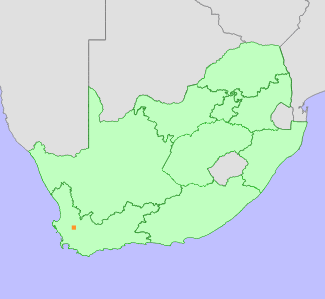|
Scientific Name | Aspalathus fasciculata (Thunb.) R.Dahlgren |
Higher Classification | Dicotyledons |
Family | FABACEAE |
Synonyms | Aspalathus involucrata E.Mey., Aspalathus undulata Eckl. & Zeyh., Heterolathus involucrata (E.Mey.) C.Presl, Ononis fasciculata Thunb. |
National Status |
Status and Criteria | Endangered B1ab(iii)+2ab(iii) |
Assessment Date | 2022/05/15 |
Assessor(s) | D. Raimondo, I. Ebrahim & B. du Preez |
Justification | A restricted range endemic known from only a handful of collections in the past 200 years, this species has an extent of occurrence (EOO) and area of occupancy (AOO) of 8 km². It is currently known from two subpopulations from a single farm, however it is likely to occur on adjacent farms and the number of locations is suspected to be between two and five. With ongoing decline in habitat quality as a result of invasive alien plants, this species qualifies for listing as Endangered under criterion B. |
Distribution |
Endemism | South African endemic |
Provincial distribution | Western Cape |
Range | This species is endemic to the Western Cape Province, where it occurs in the Groot Winterhoek Mountains. |
Habitat and Ecology |
Major system | Terrestrial |
Major habitats | Fynbos |
Description | Plants grow in montane fynbos on lower slopes, at an altitude of 200-450 m. |
Threats |
| This species occurs on lower slopes (250-400 m) of the Winterhoek Mountains, which are currently infested with aliens and threatened by the development of vineyards and orchards. Infrastucture development of roads and tourist cottages has caused loss of habitat. |
Population |
This species has rarely been collected, two small subpopulations have been recorded on iNaturalist, one in 2019 and the second observed in 2020, both subpopulations were small consisting of between 10 and 50 plants. Previously it had only two historic collections, one made in 1836 by Ecklon and Zeyher, and a second by Dahlgren in 1956. It seems highly restricted to the foothills of the Klein-Winterhoek mountains.
|
Population trend | Decreasing |
Assessment History |
Taxon assessed |
Status and Criteria |
Citation/Red List version | | Aspalathus fasciculata (Thunb.) R.Dahlgren | Data Deficient | Raimondo et al. (2009) | | Aspalathus fasciculata (Thunb.) R.Dahlgren | Rare | Hilton-Taylor (1996) | | Aspalathus fasciculata (Thunb.) R.Dahlgren | Rare | Hall et al. (1980) | |
Bibliography |
Dahlgren, R. 1988. Crotalarieae (Aspalathus). In: O.A. Leistner (ed). Flora of southern Africa 16 Fabaceae, Part 3 Papilionoideae, Fascicle 6:1-430. National Botanical Institute, Pretoria.
Goldblatt, P. and Manning, J.C. 2000. Cape Plants: A conspectus of the Cape Flora of South Africa. Strelitzia 9. National Botanical Institute, Cape Town.
Hall, A.V., De Winter, M., De Winter, B. and Van Oosterhout, S.A.M. 1980. Threatened plants of southern Africa. South African National Scienctific Programmes Report 45. CSIR, Pretoria.
Hilton-Taylor, C. 1996. Red data list of southern African plants. Strelitzia 4. South African National Botanical Institute, Pretoria.
Raimondo, D., von Staden, L., Foden, W., Victor, J.E., Helme, N.A., Turner, R.C., Kamundi, D.A. and Manyama, P.A. 2009. Red List of South African Plants. Strelitzia 25. South African National Biodiversity Institute, Pretoria.
|
Citation |
| Raimondo, D., Ebrahim, I. & du Preez, B. 2022. Aspalathus fasciculata (Thunb.) R.Dahlgren. National Assessment: Red List of South African Plants version 2024.1. Accessed on 2025/10/26 |
 Comment on this assessment
Comment on this assessment


